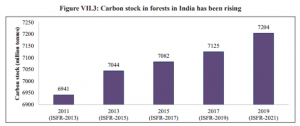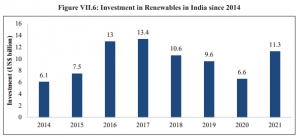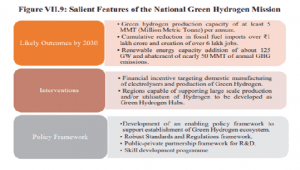THE CONTEXT: This chapter presents an updated discussion on the issue of climate change from India’s perspective, including a discussion on forests and their role in mitigating carbon emissions, an approach to transition to renewable energy and the recently submitted low emissions development strategy. The chapter further presents a discussion on the outcomes of the 27th session of the Conference of Parties (COP 27), progress made on enabling financing for sustainable development and India’s role in global efforts towards addressing climate change. Besides this, recent changes in environmental regulations and other environmental aspects, such as biodiversity and wildlife, are also discussed.
- Climate change is the long-term change in temperature and weather patterns that can occur due to natural reasons, but since the beginning of the industrial revolution in the 19th century, it has been predominantly due to anthropogenic activities.
- Much of the global angst associated with climate change is about the emission of GHGs and carbon, in particular. The more GHGs are emitted, the more they stay trapped in the atmosphere, accelerating global warming. Hence, the argument goes that if some of the cataclysmic consequences are to be avoided, then global warming must be arrested, slowed and, if possible, reversed.
One way to strive for it is to reduce emissions of GHG, including carbon. Many nations pledge to reduce their net emission to zero by 2050. Some wish to achieve it by 2060 and by 2070.

- However, this is where things begin to get interesting. Science is not very clear on whether further emission reduction would necessarily guarantee a stoppage or reversal of global warming.
- The IPCC’s Sixth Assessment Report (AR6) notes that high human vulnerability global hotspots are found particularly in West, Central & East Africa, South Asia, Central, and South America, Small Island Developing States, and the Arctic.
- The fact that climate change is a global phenomenon and requires collective efforts has been widely accepted and is the basis of the commitments in the United Nations Framework Convention on Climate Change (UNFCCC) and its Paris Agreement.
- Recognizing the differentiated responsibility of countries (in view of their role in GHG emissions) and the higher developmental needs of the developing countries, they call for a collective action based on the principles of equity and Common But Differentiated Responsibility and Respective Capabilities (CBDR-RC).
- The collective action has translated into NDCs-through which each country has made a commitment to work towards a collective goal of keeping temperature rise to below 2° C above pre-industrial levels.
- India has been striving to pursue the goal of sustainable development. It spearheads one of the most robust climate actions through its NDCs, which includes an ambitious programme for transitions to clean energy in the world.
PROGRESS ON INDIA’S CLIMATE ACTION
- India’s climate vision is integrally linked to its vision of development that foregrounds the goals of poverty eradication and guaranteeing basic well-being to all its citizens. Action on addressing climate action was initiated even before the Paris Agreement came into being.
- In 2008, India launched the National Action Plan on Climate Change (NAPCC), establishing eight National Missions, covering several initiatives and a slew of measures in the area of solar, water, energy efficiency, forests, sustainable habitat, sustainable agriculture, sustaining Himalayan ecosystem, capacity building and research and development (R&D).

- National Adaptation Fund for Climate Change (NAFCC), a central sector scheme, was initiated in 2015-16 to support adaptation activities in the States and Union Territories (UTs) of India that are vulnerable to the adverse effects of climate change.
India’s updated Nationally Determined Contribution (NDC)
- Article 4 of the Paris Agreement provides that each Party shall communicate or update its NDC every five years.
- India submitted its first NDC to UNFCCC in October 2015. This was updated in August 2022.
- The 2015 NDC comprised eight goals, three of which were quantitative targets to be achieved up to 2030.
- The three targets included cumulative electric power installed capacity from non-fossil sources to reach 40 per cent, reduction in the emissions intensity of GDP by 33 to 35 per cent compared to 2005 levels, and creation of additional carbon sink of 2.5 to 3 billion tonnes of CO2 equivalent through additional forest and tree cover.
India, at COP26 in Glasgaw, has presented the following five nectar elements (Panchamrit) of India’s climate action:
- Reach 500 GW Non-fossil energy capacity by 2030.
- 50 per cent of its energy requirements from renewable energy by 2030.
- Reduction of total projected carbon emissions by one billion tonnes from now to 2030.
- Reduction of the carbon intensity of the economy by 45 per cent by 2030, over 2005 levels.
- Achieving the target of net zero emissions by 2070.
STATUS OF FOREST AND TREE COVER
- One of the three quantifiable targets of India’s NDC is to achieve an additional carbon sink of 2.5 billion to 3.0 billion tonnes through additional forest and tree cover by 2030. The forest and tree cover in India has shown a gradual and steady trend of increase in the last one and a half decades.
- The country ranks third globally with respect to the net gain in average annual forest area between 2010 and 2020.
- Schemes like the Green India Mission (GIM), Compensatory Afforestation Fund Management and Planning Authority (CAMPA), National Afforestation Programme (NAP), Green Highway Policy – 2015, Policy for enhancement of Urban Greens, National Agro-forestry Policy, and Sub-Mission on Agro-forestry (SMAF), are among the most important ones.
CARBON STOCK IN INDIA’S FOREST AND TREE COVER
- The Indian State of Forest Report (ISFR) estimates the carbon stock of forests to be about 7,204 million tonnes in 2019 , which is an increase of 79.4 million tonnes of carbon stock as compared to the estimates of the previous assessment for 2017.

PRESERVATION OF ECOSYSTEMS: A CRITICAL ADAPTATION ACTION
- Ecosystems play an important role in carbon storage, protect the coastal areas, and enhance water quality besides other services, such as cultural, spiritual or tourist attractions. Wetlands are natural buffers against floods, droughts, and tropical cyclones.
- Mangroves and coastal wetlands form the first line of defence for coastal communities against increased storm surges, flooding, and hurricanes.
- The Government has taken both regulatory and promotional measures to protect and conserve mangroves.

Importance of Mangroves:
- Mangroves have a complex root system that is very efficient in dissipating sea wave energy thus protecting the coastal areas from tsunamis, storm surges, and soil erosion. E.g. they played important role in Tsunami of 2004.
- Mangrove roots slow down water flows and enhance sediment deposition. Therefore, they act as a zone of land accretion due to the trapping of fine sediments including heavy metal contaminants.
- They also arrest coastal erosion and sea water pollution.
- They act as a fertile breeding ground for many fish species and other marine fauna. Therefore, they have high biodiversity.
- They act as an important source of livelihood for the coastal communities dependent on the collection of honey, tannins, wax, and fishing.
- Mangroves are important carbon sinks.
RIVER CONSERVATION AND REJUVENATION
- The Government is working on mapping and converging the 5Ps’ – People, Policy, Plan, Programme and Project.
- The government has recently released Detailed Project Reports (DPR) for the rejuvenation of 13 major rivers prepared by the Indian Council of Forestry Research and Education (ICFRE), Dehradun in consultation with the State Forest Departments and other line Departments.
APPROACH TO TRANSITION TO RENEWABLE ENERGY SOURCES
- While the target was to achieve 40 per cent of the installed electric capacity from non-Fossil fuel sources by 2030 in the initial NDC submitted in 2015, the target has already been achieved.
- India is now striving to achieve the target of 50 per cent cumulative electric power installed capacity from non-fossil fuel-based energy resources by 2030, in line with updated NDCs.

- India is progressively becoming a favoured destination for investment in renewables. As per the Renewables 2022 Global Status Report, during the period 2014 -2021, total investment in renewables stood at US$ 78.1 billion in India.

- The likely installed capacity of electricity capacity by the end of 2029-30 is expected to be more than 800 GW of which non-fossil fuel would be more than 500 GW.

GREEN HYDROGEN-A CRITICAL SOURCE OF ALTERNATE ENERGY
- With a vision to make India an energy-independent nation, and to de-carbonize critical sectors, the Government approved the National Green Hydrogen Mission on January 4, 2023. The Mission will facilitate demand creation, production, utilization and export of Green Hydrogen.

LONG-TERM LOW EMISSIONS DEVELOPMENT STRATEGY (LT-LEDS)
India submitted its Long-Term Low Carbon Development Strategy (LT-LEDS) on November 14, 2022, at COP 27.
- Focus on the rational utilization of national resources with due regard to energy security.
- Encompasses the objectives of the National Hydrogen Policy.
- Increased use of biofuels, especially ethanol blending in petrol.
- Climate-resilient urban development will be driven by smart city initiatives.
- India’s industrial sector will continue on a strong growth path, with the vision of ‘Aatmanirbhar Bharat’ and ‘Make in India’.
FINANCE FOR SUSTAINABLE DEVELOPMENT
GREEN BONDS
- Green bonds are financial instruments that generate proceeds for investment in environmentally sustainable and climate-suitable projects.
- In keeping with the ambition to reduce the carbon intensity of the economy significantly, the Union Budget 2022-23 announced the issue of Sovereign Green Bonds.
- The Reserve Bank of India (RBI) has notified the indicative calendar for the issuance of Sovereign Green Bonds (SGrBs) for the fiscal year 2022-23.
- The issuance would take place through two auctions on January 25, 2023 and February 9, 2023, respectively, for ₹8,000 crore each, totalling ₹16,000 crore.
REGULATORY FRAMEWORK FOR ISSUANCE OF GREEN DEBT SECURITIES
- SEBI introduced the regulatory framework for issuance of green debt securities as a mode of sustainable finance under the erstwhile SEBI.
INVESTING IN RESILIENCE FOR SUSTAINABLE DEVELOPMENT
- SEBI has issued new sustainability reporting requirements under the Business Responsibility and Sustainability Report (BRSR), which are more granular with quantifiable metrics in line with the principles ensconced in the ‘National Guidelines on Responsible Business Conduct’.
MAJOR DECISIONS AT COP 27
- India participated in COP 27, with a focus on mainstreaming the theme of LiFE – Lifestyle for Environment.
- Importance of the transition to sustainable lifestyles and sustainable patterns of consumption and production for efforts to address climate change.
- To establish new funding arrangements for assisting developing countries that are particularly vulnerable to the adverse effects of climate change in responding to loss and damage.
- The importance of science in guiding climate action, doubling adaptation finance, dialogue on making finance flows consistent with low-emissions, and climate-resilient development calls on Multilateral Development Banks (MDB) reform for delivering climate finance at scale; diversity of sources of finance (including new and additional finance), etc.
- The target of US$ 100 billion per year is yet to be achieved.
INDIA’S INITIATIVES AT THE INTERNATIONAL STAGE
INTERNATIONAL SOLAR ALLIANCE (ISA)
- The International Solar Alliance (ISA) is a treaty-based inter-governmental organization working to create a global market system to tap the benefits of solar power and promote clean energy applications.
- ISA’s mission is to unlock US$ 1 trillion of investments in solar by 2030 while reducing the cost of the technology and its financing.
- With the signing and ratification of the ISA Framework Agreement by 15 countries on 6 December 2017, ISA became the first international intergovernmental organisation to be headquartered in India (at Gurugram, Haryana).
- ISA has expanded its coverage to all its 110 member countries.
COALITION FOR DISASTER RESILIENT INFRASTRUCTURE
- CDRI was launched by the Hon’ble Prime Minister of India during the United Nations Climate Action Summit on 23 September 2019 in New York.
- It is a global partnership of National Governments, UN agencies and programmes, multilateral development banks and financing mechanisms, the private sector, and academic and knowledge institutions.
- It aims to promote the resilience of infrastructure systems to climate and disaster risks, thereby ensuring sustainable development.
- As on 29 June 2022, thirty-one Countries, six International Organisations and two private sector organisations have joined as members of CDRI.
Leadership Group for Industry Transition (LeadIT)
- The LeadIT gathers countries and companies that are committed to action to achieve the Paris Agreement. It was launched by the governments of Sweden and India at the UN Climate Action Summit in September 2019 and is supported by the World Economic Forum.
INITIATIVES RELATED TO OTHER ENVIRONMENTAL ISSUES
ENSURING THE CONSERVATION OF BIODIVERSITY
- The 1992 Earth Summit held at Rio de Janeiro led to the adoption of an internationally binding legal instrument, the Convention on Biological Diversity (CBD), with the objectives of conservation, sustainable use, and fair and equitable sharing of benefits arising from the use of biological diversity.
- May 22nd is celebrated as an International Day for Biological Diversity every year globally.
- India ranks eighth in the world and fourth in Asia among the mega-diverse countries in the world.
- The fifteenth meeting of the Conference of Parties (COP 15) to the Convention on Biological Diversity (CBD) took place between 7th and 19th December 2022 in Montreal, Canada.
Key outcomes of the COP 15 to CBD include-
- Effective conservation and management of at least 30 per cent of the world’s lands, inland waters, coastal areas, and oceans. Currently, 17 per cent and 10 per cent of the world’s terrestrial and marine areas are under protection.
- Reduce to near zero the loss of areas of high biodiversity importance.
- Cut global food waste in half and significantly reduce overconsumption and waste generation.
- Reduce by half both excess nutrients and the overall risk posed by pesticides and highly hazardous chemicals.
- Progressively phasing out or reforming subsidies that harm biodiversity by 2030 by at least US$500 billion per year while scaling up positive incentives for biodiversity’s conservation and sustainable use.
- Mobilise by 2030 at least US$ 200 billion per year in domestic and international biodiversity-related funding from all sources – public and private.
- Raise international financial flows from developed to developing countries, in particular, least developed countries, small-island developing States, and countries with economies in transition, to at least US$ 20 billion per year by 2025 and to at least US$ 30 billion per year by 2030.
- India and Nepal signed a Memorandum of Understanding (MoU) in August 2022 on biodiversity conservation to strengthen and enhance the coordination and cooperation.
WILDLIFE – ITS PRESERVATION AND PROTECTION
- Enacted in 1972 called the Wildlife (Protection) Act 1972 to provide special legal protection to our wildlife and endangered species. The Act has been amended multiple times to strengthen conservation measures.
- India is home to 54 Tiger Reserves covering approximately 75,796.8 sq. km area in 18 States, with about 75 per cent of the wild tiger population at the global level.
- 17 Tiger Reserves in the country have CA|TS international accreditation and and two have received International Tx2 Award.
The TX2 Tiger Conservation Award is given away by Conservation Assured | Tiger Standards (CA|TS), Fauna & Flora International, Global Tiger Forum, IUCN Integrated Tiger Habitat Conservation Programme, Panthera, UNDP Lion’s Share, Wildlife Conservation Society, and World Wide Fund For Nature’s (WWF’s) Tigers Alive Initiative.
- India now (2020) has 12,852 leopards compared to the previous estimate of 7910 conducted in 2014.
- The current population estimates indicate about 50,000 – 60,000 Asian elephants worldwide. More than 60 per cent of the population is in India.
Government has brought in the Wildlife (Protection) Amendment Act, 2022. The Act seeks to –
- increase the number of species protected under the law and implement the Convention on International Trade in Endangered Species of Wild Fauna and Flora (CITES).
- The Wildlife (Protection) Act 1972 has six schedules. The Act aims to rationalise the schedules by
(i) reducing the number of schedules for specially protected animals to two,
(ii) removing the schedule for vermin species, and
(iii) inserting a new schedule for specimens listed in the Appendices under CITES (scheduled specimens).
- the Act empowers the government to regulate or prohibit the import, trade, possession or proliferation of invasive alien species.
Plastic Waste Management and Elimination of Identified Single-Use Plastics
- On July 1, 2022, a ban was imposed on the manufacture, import, stocking, distribution, sale and use of identified single-use plastic items, which have low utility and high littering potential, all across the country.
Battery Waste Management
- The Government published the Battery Waste Management Rules, 2022, on August 24, 2022 to ensure environmentally sound management of waste batteries.
E-waste Management
- The Government notified the E-Waste (Management) Rules, 2022, on November 2, 2022. These rules will replace the E-waste (Management) Rules, 2016.
- Under these rules, a provision for reducing hazardous substances in the manufacturing of EEE has been provided. It mandates that every producer of EEE and their components shall ensure that their products do not contain lead, mercury, and other hazardous substances beyond the maximum prescribed concentration.
THE CONCLUSION: India is spearheading one of the world’s most ambitious clean energy transitions and remains steadfast in its commitment to combating climate change. Despite the adverse impacts of Covid-19 on the economy, India has enhanced its climate ambition manifold and embarked on a long-term strategy towards a Low GHG Emission Development Strategy by adopting a multi-pronged approach.
Spread the Word
